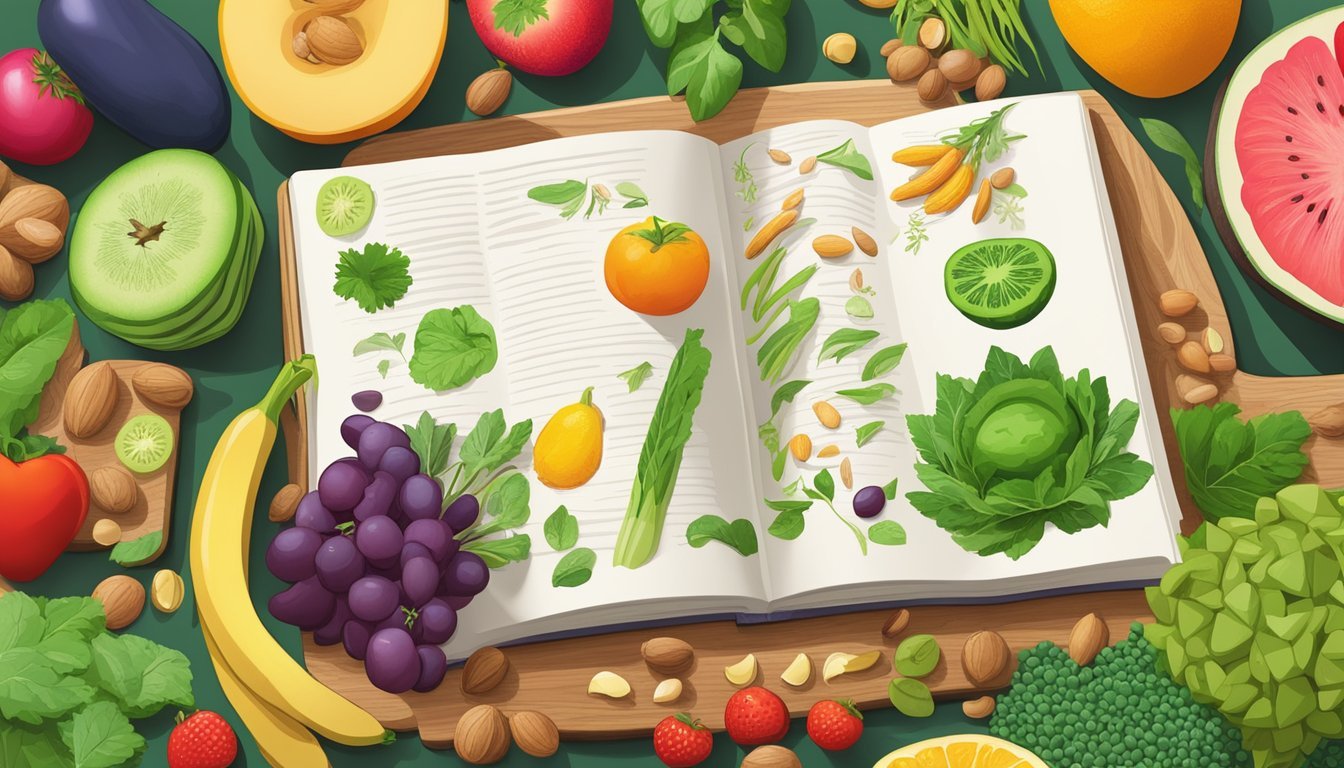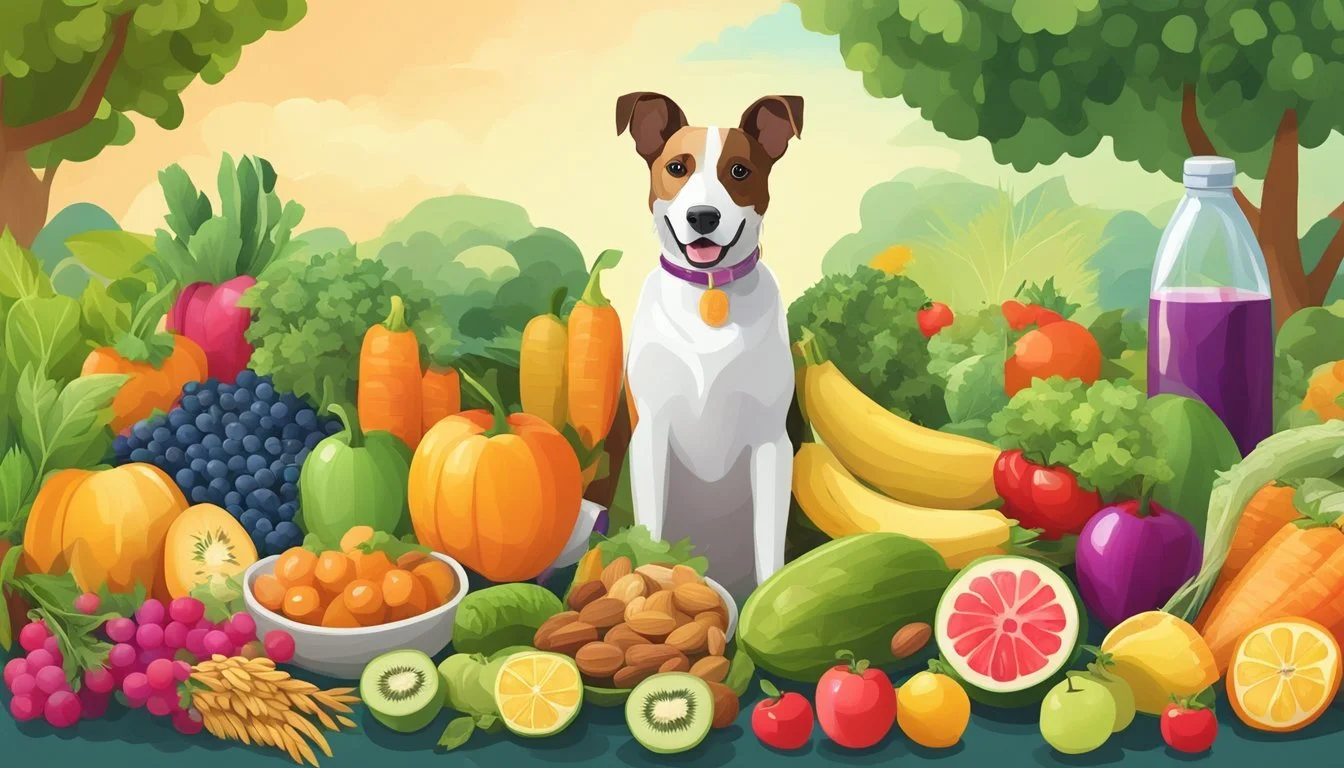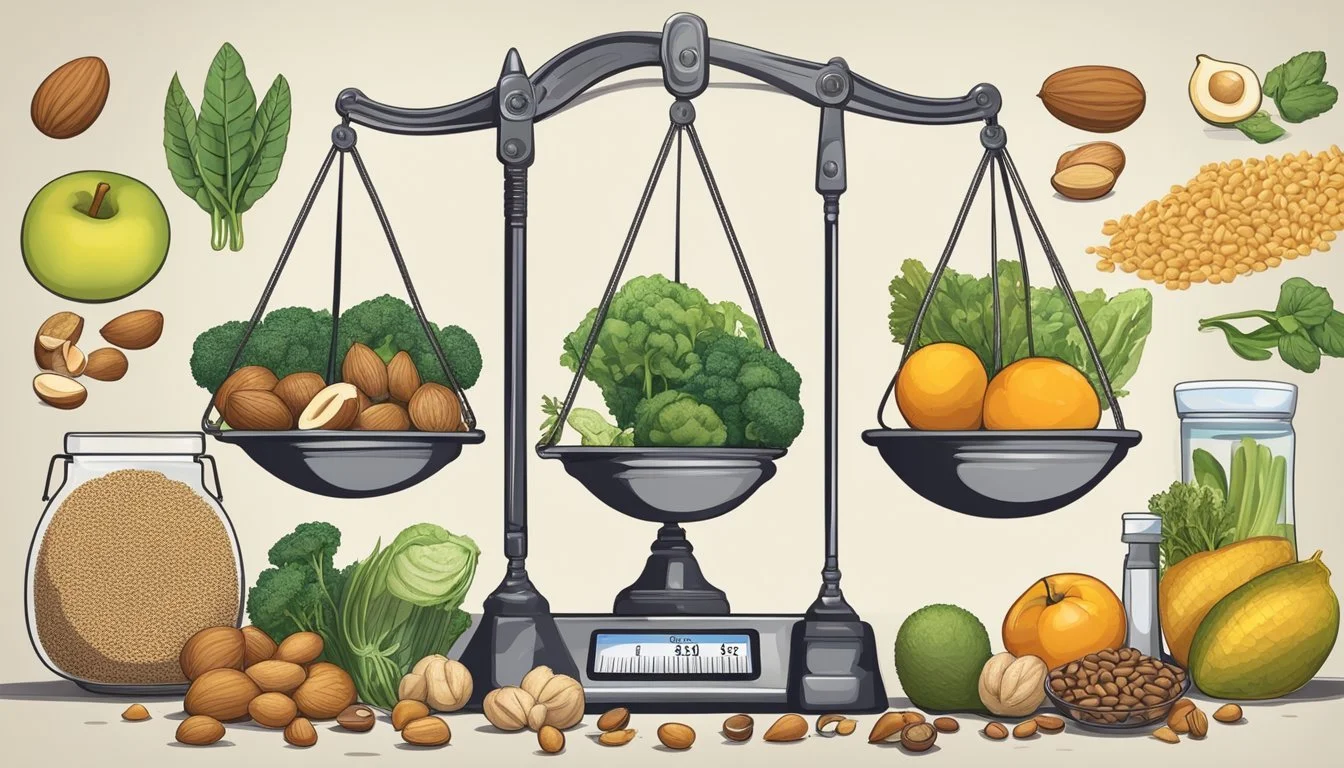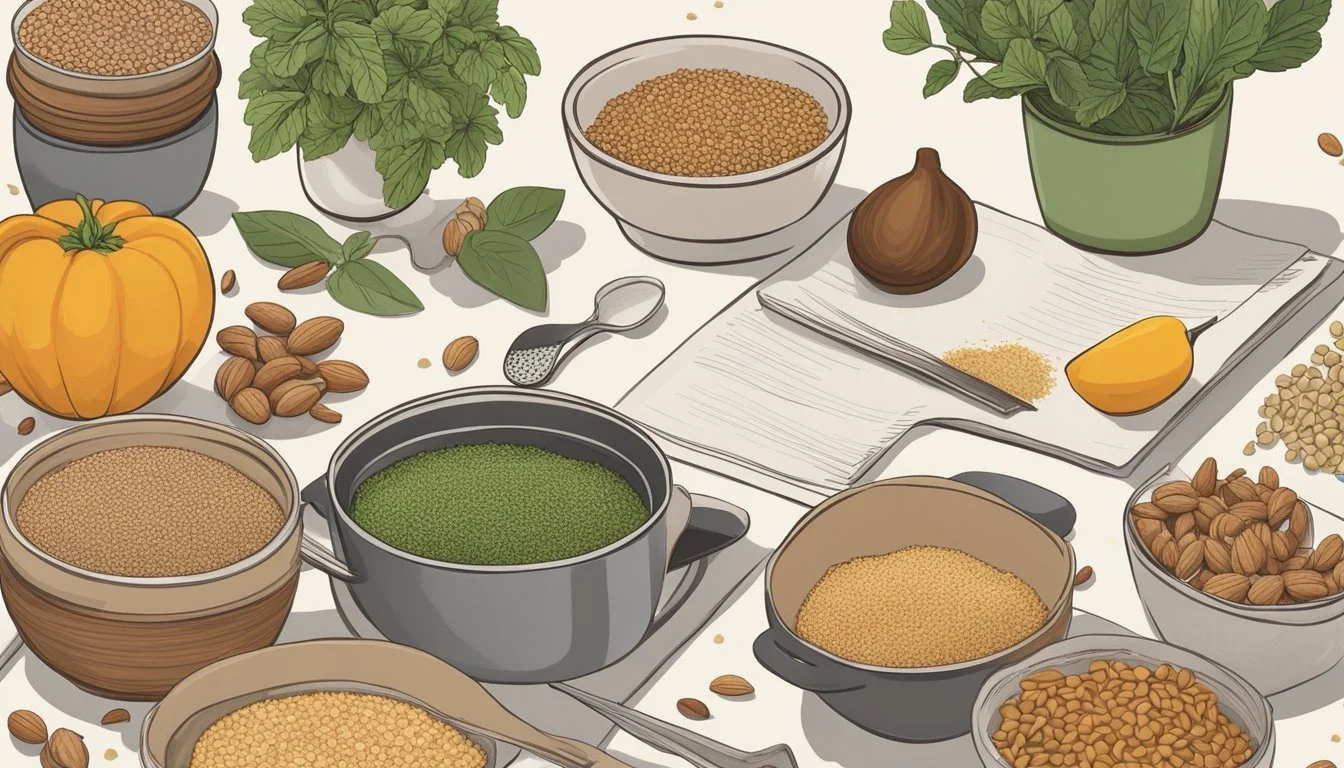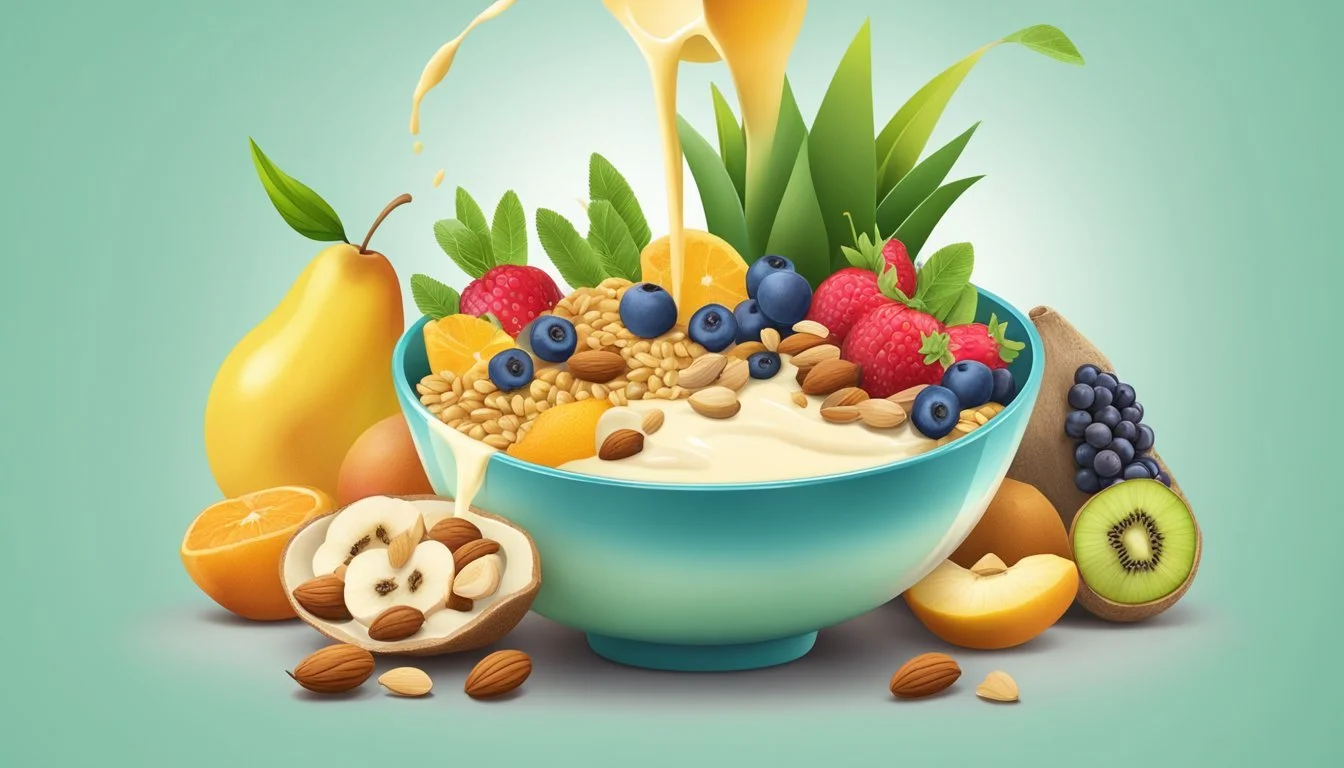Grain-Free and Vegan
Finding the Balance for Nutritional Wholeness
Adopting a grain-free and vegan lifestyle represents a commitment to eating whole, plant-based foods while simultaneously eliminating all grains. This dietary choice is often motivated by health concerns, food sensitivities, or ethical reasons. The basis of a grain-free vegan diet includes vegetables, fruits, legumes, nuts, seeds, and alternative flours, which provide a diverse range of nutrients and health benefits.
The challenge lies in ensuring a balanced diet that meets all nutritional needs. Eliminating grains means forgoing traditional sources of vegan protein and fiber such as wheat, oats, and barley. However, with careful planning, one can incorporate protein-rich foods like quinoa, amaranth, and buckwheat, which are technically seeds, and thus align with the grain-free diet, as well as legumes and soy products for a well-rounded nutrient profile.
This dietary approach encourages creativity in the kitchen, leading to innovative recipes that not only adhere to grain-free and vegan principles but also cater to a variety of palates and preferences. Embracing such a diet invites exploration of a multitude of flavors, textures, and nourishing ingredients that can contribute to a sustainable and healthful way of eating.
Embracing a grain-free and vegan lifestyle offers a wonderful opportunity to prioritize health, sustainability, and compassion while savoring a diverse array of nourishing foods. By combining the principles of grain-free living with a vegan approach, individuals can enjoy a vibrant and satisfying way of eating that supports overall well-being.
Understanding the role of grains in human health history and their impact on grain-free hormonal balance can deepen the appreciation for adopting a grain-free and vegan lifestyle. Being mindful of grain-free hidden grains labels and incorporating versatile grain-free flour alternatives into vegan recipes ensures that individuals can adhere to their dietary goals while relishing delicious meals.
For those managing grain-free carb cravings, incorporating wholesome grain-free dog treats into the vegan approach can provide a satisfying solution to support overall wellness and balance.
Cultivating a grain-free garden can also be a fulfilling way to embrace a grain-free and vegan lifestyle, allowing individuals to grow their own produce and connect with the earth in a sustainable and nourishing manner.
By uniting the benefits of grain-free and vegan living, individuals can savor a wealth of culinary experiences, prioritize their health, and revel in the joys of a lifestyle that celebrates nourishment, vitality, and ethical choices.
Understanding Grain-Free and Vegan Diets
When exploring dietary lifestyles, it's essential to comprehend the principles behind grain-free and vegan diets, their nutritional impact, and the common misconceptions.
Defining Grain-Free and Vegan
Grain-Free Diet: A grain-free diet eliminates all grains, including wheat, rice, oats, and barley. Often adopted by those who are gluten-free, it focuses on consuming other carbohydrate sources, like starchy vegetables and seeds such as quinoa and buckwheat.
Vegan Diet: A vegan diet excludes all animal products, making it dairy-free and plant-based. Vegans focus on fruits, vegetables, legumes, nuts, and seeds to fulfill their dietary requirements.
Nutritional Considerations
Grain-Free Challenges: Removing grains can reduce the intake of important B vitamins and fiber. Those following this diet must ensure they acquire these nutrients from other sources.
Essential Nutrients Alternative Grain-Free Sources Fiber Fruits, Vegetables, Legumes, Nuts B Vitamins Nutritional Yeast, Leafy Greens, Eggs
Vegan Essentials: A vegan diet must be carefully planned to prevent deficiencies, particularly in protein, vitamin B12, iron, calcium, and omega-3 fatty acids.
Nutrients Vegan Sources Protein Lentils, Chickpeas, Tofu, Quinoa B12 Fortified Foods, Supplements Iron Spinach, Fortified Cereals, Legumes Calcium Almonds, Kale, Fortified Plant Milks Omega-3 Flaxseeds, Chia Seeds, Hemp Seeds
Common Misconceptions
Grains Are Simply Carbs: Grains offer more than just carbohydrates; they are also a source of protein and fiber, which are critical for balanced nutrition.
Vegan Diets Lack Protein: Vegans can get adequate protein from plant sources, but it requires careful meal planning to include a variety of protein-rich foods.
Grain-Free Is Always Healthier: This diet isn't inherently healthier for everyone; it's beneficial for those with grain sensitivities or specific health goals but not necessary for the general population.
It's important for individuals to research and consult nutrition experts when considering significant dietary changes, such as adopting a grain-free or vegan diet, to ensure that their overall nutrition remains balanced and healthful.
Benefits of Combining Grain-Free and Vegan Lifestyles
The merging of grain-free and vegan lifestyles can lead to improvements in nutritional health and have a positive environmental impact. By carefully selecting foods, individuals can create a dietary pattern that supports wellbeing and ecological sustainability.
Health Benefits
A grain-free vegan diet typically eliminates processed foods, refined sugars, and most common allergens, such as gluten and dairy. This has the potential to reduce inflammation in the body and promote better digestive health. As an example, individuals may consume a higher amount of vegetables, which are rich in essential nutrients. The staple food items in a grain-free vegan diet include:
Vegetables: High intake of green vegetables like kale and broccoli, which are loaded with vitamin K, and orange vegetables like carrots, rich in vitamin A.
Healthy Fats: Incorporation of good fats from sources such as avocados, extra-virgin olive oil, flaxseeds, and chia seeds which are essential for absorption of fat-soluble vitamins.
Protein Sources: Plant-based proteins like legumes, nuts, and seeds that provide the building blocks for muscle maintenance without the need for animal products.
Environmental Impact
Choosing a grain-free vegan diet can also contribute to environmental conservation. This dietary approach often requires less water and land resources and leads to a lower carbon footprint than diets involving animal products. Agriculture for animal feed is resource-intensive; for example, producing a pound of chicken meat requires multiple pounds of grain as feed. By consuming plant-based foods directly, one reduces the demand on these resources, making this diet both health-conscious and environmentally responsible.
Challenges and Solutions
Embarking on a grain-free and vegan lifestyle requires careful consideration of nutritional balance, creative cooking approaches, and social adaptability. The following subsections address common hurdles and practical strategies to maintain this dietary choice successfully.
Meeting Nutritional Needs
A primary concern for individuals on a grain-free vegan diet is ensuring adequate nutrient intake. Grains are traditionally a source of vitamins and minerals, so it's essential to find alternatives that provide similar nutritional value.
Omega-3 Fatty Acids: Replace the ALA sources from grains with flaxseeds, chia seeds, hemp seeds, and walnuts. Include leafy greens and consider algae-based supplements for EPA and DHA.
Protein: Incorporate a variety of nuts, seeds, and legumes like lentils and chickpeas.
Calcium and Vitamin D: Choose fortified non-dairy milks such as almond milk or soy milk. Add tofu, tahini, and leafy greens to the diet.
B Vitamins: Nutritional yeast and specific fortified foods can help prevent deficiencies.
Substitutes in Baking and Cooking
Successfully adapting recipes while maintaining a grain-free and vegan diet involves finding suitable substitutes that mimic the properties of the omitted ingredients.
Flour alternatives: Use nut flours such as almond or coconut flour. Remember to adjust the amount, as these flours have different absorption rates.
Binders: To replace eggs, use flax or chia seeds mixed with water. Applesauce or mashed bananas can also be effective.
Fat sources: Vegan butter or coconut oil work well in place of dairy butter.
Sweeteners: Opt for natural sweeteners like maple syrup or agave instead of refined sugar.
When baking, always preheat the oven to ensure even cooking, and consider using a gluten-free baking mix for convenience.
Dining Out and Social Events
Navigating social situations on a grain-free vegan diet can be challenging but manageable with strategic planning.
Research restaurants: Look for venues that offer gluten-free and vegan options or are willing to accommodate special dietary requests.
Communicate needs: Don't hesitate to explain your dietary restrictions to the host or chef.
Bring a dish: When attending events, consider bringing a grain-free vegan dish. It ensures there's something for you to enjoy and introduces others to your diet.
By adopting these solutions, individuals can confidently sustain a grain-free and vegan lifestyle, mitigating the risk of nutritional deficiencies and social constraints.
Grain-Free Vegan Ingredients and Substitutions
Adapting to a grain-free vegan lifestyle requires creativity in selecting alternatives for traditional ingredients. This section provides a look at the various substitutes one can employ for flours, thickeners, binders, leavening agents, sweeteners, and flavor enhancers within this dietary framework.
Flours and Thickeners
Almond Flour: Produced from finely ground almonds, almond flour serves as a staple in grain-free vegan baking, offering a high-protein and gluten-free alternative to wheat flour.
Coconut Flour: Made from dried coconut meat, coconut flour is another gluten-free option that adds a mildly sweet taste and is highly absorbent, requiring more liquid in recipes.
Tapioca Flour: Derived from the cassava root, tapioca flour is used for thickening soups and sauces due to its neutral flavor and smooth texture.
Arrowroot Powder: A versatile thickener that's gluten-free and Paleo-friendly, arrowroot powder is ideal for creating a glossy finish in dishes without the use of grains.
Binders and Leavening Agents
Flaxseeds: When ground and mixed with water, flaxseeds form a gel-like consistency, making them an excellent binder in vegan baking.
Baking Soda & Baking Powder: As leavening agents, both baking soda and baking powder are grain-free and help to provide lift and aeration in baked goods.
Apple Cider Vinegar: Often paired with baking soda, apple cider vinegar aids in the rising process, imparting lightness to cakes and muffins without the use of grains.
Sweeteners and Flavor Enhancers
Maple Syrup: A plant-based, natural sweetener that's grain-free, maple syrup adds moisture and a rich, caramel-like taste to recipes.
Coconut Sugar: With a lower glycemic index than regular sugar, coconut sugar offers a similar sweetness, making it a favorable option for those avoiding grains and refined sugars.
Vanilla Extract: Offering a warm, complex flavor, pure vanilla extract enhances the taste of vegan desserts without adding grains.
Cinnamon: Known for its aromatic warmth, cinnamon is a common spice that elevates the flavor profile of grain-free vegan dishes across the board.
Recipe Development and Adaptation
Developing and adapting recipes to be both grain-free and vegan requires careful ingredient selection and an understanding of how these ingredients interact to replicate the qualities of traditional baked goods.
Converting Traditional Recipes
When converting traditional recipes to grain-free and vegan versions, one must replace both the grains and any animal-derived ingredients. To achieve a soft and fluffy texture common in baked goods, flax "eggs" can be used as a vegan replacement for eggs. It involves mixing ground flax seeds with water which acts as a binding agent. Almond flour is a popular choice for a grain-free alternative, giving a similar structure that wheat flour would provide.
For dairy ingredients like butter, coconut oil can be utilized as a direct substitute to retain the richness and moisture. It is solid at room temperature like butter, making it suitable for recipes that require a solid fat. Moreover, baking times and temperatures may need slight adjustments, as ingredients like almond flour can brown more quickly. Generally, the prep time and cook time may vary from the original recipe, so it's critical for one to keep a close eye on the oven during the initial test batches of the adaptation process.
Balancing Taste and Texture
Achieving the right balance of taste and texture is a cornerstone in recipe adaptation. For taste, buckwheat, despite its name, is a gluten-free seed with an earthy flavor that can provide a taste profile similar to whole grains. It works well in recipes that are enhanced by its robust flavor. Texture, on the other hand, relies on the correct ratio of wet to dry ingredients.
In vegan baking, obtaining a texture that matches traditional recipes can be challenging due to the absence of gluten, which offers elasticity and structure. Utilizing a combination of grain-free flours like almond or buckwheat can help one mimic what's lost when omitting grains. Additionally, the use of binders such as xanthan gum can help in providing the desired chewiness or structure in baked goods like breads and cakes.
Careful attention to the balance of flavors and structure ensures that the final vegan, grain-free recipe is both appealing to the palate and satisfactory in mouthfeel. While recipe development is a process of trial and error, the focus on these key elements can lead to delicious results.
Essential Grain-Free Vegan Recipes
Adopting a grain-free vegan diet doesn't mean compromising on taste or variety. This section covers key recipes that will keep meals interesting and delicious throughout the week, from the first bite of breakfast to the last crumb of dessert.
Breakfast Options
Grain-free breakfasts can be both fulfilling and energizing. One can start their day with Fluffy Grain-Free Pancakes made from a blend of almond and coconut flours, giving a satisfying start to the morning. The pancakes can be made even more delightful by adding blueberries or a dash of cinnamon. For those who prefer a savory beginning, a Tomato and Spinach Chickpea Omelette offers a high-protein option with the fluffy texture achieved through chickpea flour.
Grain-Free Pancakes Ingredients:
Almond flour
Coconut flour
Baking powder
Non-dairy milk
Maple syrup (optional)
Chickpea Omelette Ingredients:
Chickpea flour
Nutritional yeast
Spinach
Tomato
Turmeric
Main Courses
Main courses in a grain-free vegan diet are diverse and hearty. A popular dish is Cauliflower and Potato Soup that boasts a creamy texture without any grains. The soup is simmered with aromatic spices, chopped celery, and a vegetable broth base, garnished with corn kernels for added sweetness. Another mainstay is Fesenjan, a Persian stew with walnuts and pomegranate molasses served over roasted cauliflower instead of rice. It's a dish rich in flavors and can be prepared in under half an hour.
Cauliflower and Potato Soup Ingredients:
Cauliflower
Potatoes
Onion
Garlic
Vegetable broth
Celery
Fesenjan Ingredients:
Ground walnuts
Cauliflower
Pomegranate molasses
Cinnamon
Desserts and Treats
Grain-free vegan desserts can satisfy any sweet tooth. For instance, Chocolate Chip Cookies, baked until warm and crisp, make use of almond flour to deliver that conventional cookie taste and texture. When baking, it's recommended to use parchment paper for ease of removal from the pan. On the other hand, for a more elaborate treat, one might bake a batch of Cinnamon Rolls. These buns can be made without traditional grains by using a mixture of gluten-free flours and are best served warm, with the inviting scent of cinnamon filling up the kitchen.
Chocolate Chip Cookies Ingredients:
Almond flour
Vegan chocolate chips
Coconut oil
Maple syrup
Cinnamon Rolls Ingredients:
Gluten-free all-purpose flour
Cinnamon
Vegan butter
Yeast
Non-dairy milk
Incorporating these essential recipes into a grain-free vegan lifestyle ensures that every meal is not only nutritious but also full of flavor.
Maintaining a Balanced Diet
Achieving a balanced diet while adhering to grain-free and vegan guidelines requires strategic planning and a keen understanding of nutritional needs.
Meal Planning and Preparation
Meal planning starts with a thoughtfully crafted grocery list, focusing on a variety of vegetables, fruits, legumes, and seeds that are inherently grain-free and vegan. Individuals should set aside time to prepare meals for the week, with an emphasis on diversity and ease of preparation to ensure compliance and reduce reliance on takeout options. For instance, a grain-free vegan might prep batches of quinoa, a protein-rich pseudo-cereal, as a base for meals. Vegan milk substitutes like almond or coconut milk can be used for creating vanilla or chocolate-flavored desserts or beverages, maintaining the enjoyment of diverse flavors while adhering to diet guidelines.
Monitoring Macronutrients and Calories
Monitor intake of macronutrients—protein, fats, and carbohydrates—to ensure they meet their nutritional needs without the inclusion of grains. Vegan dieters must pay particular attention to protein sources, utilizing legumes—such as lentils and chickpeas—and seeds like chia and hemp to meet their requirements. They must also ensure sufficient calories are consumed to maintain weight, as grain-free vegan diets can naturally skew lower in calorie density. Nutritional yeast is a valuable addition for B-vitamins and has a cheesy flavor, making it a popular choice for those avoiding dairy.
Incorporating a variety of nutrient-dense, whole foods while paying attention to key vitamins and minerals helps maintain a well-rounded diet. Those following a grain-free vegan diet may need to supplement to cover any nutritional gaps, especially for nutrients typically found in whole grains.
Practical Tips and Lifestyle Advice
Adopting a grain-free and vegan diet necessitates careful planning and informed choices to ensure a balanced intake while managing costs. By focusing on practical strategies for shopping and budgeting, as well as maintaining motivation through reliable information, individuals can successfully navigate this lifestyle.
Shopping and Budgeting
When embarking on a grain-free vegan diet, one's weekly plan should prioritize a budget-conscious approach to grocery shopping. They might start by making a detailed list of grain-free vegan ingredients, focusing on bulk purchases for items like seeds and nuts, which are staples in a grain-free pantry. Quinoa, amaranth, and buckwheat are ideal nutrient-dense seeds to include as they are not true grains. Fresh produce should also be a significant part of the budget, with an emphasis on a wide variety of vegetables.
Key Budget Tips:
Purchase seasonal produce to save money and enjoy better flavor.
Explore local farmers' markets for competitive prices and fresh options.
Invest in high-quality, plant-based proteins like legumes and tofu, which are cost-effective and versatile.
Staying Motivated and Informed
Motivation is crucial for maintaining a grain-free vegan lifestyle. Individuals should seek out credible sources of information, as accurate knowledge on nutrition can empower them to make wholesome diet choices. Engaging with online communities or following vegan dietitians can provide support and new recipe ideas to keep meals interesting. Additionally, they might set achievable goals, such as trying one new recipe per week to sustain excitement and commitment to their diet.
Motivational Strategies:
Subscribe to newsletters or blogs from trusted plant-based health experts.
Join digital forums or social media groups dedicated to grain-free vegan living.
Utilize meal planning apps that cater specifically to vegan and grain-free diets to simplify the process.

